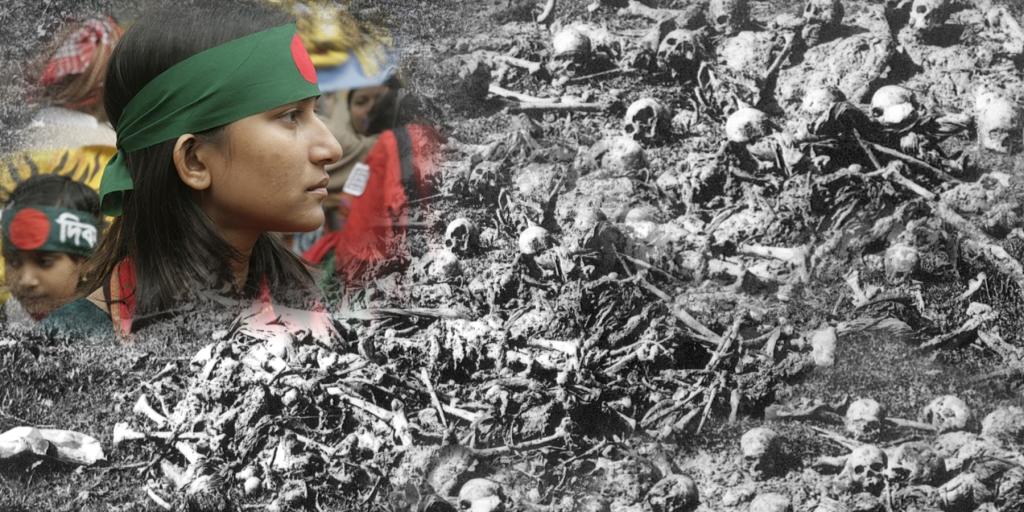
From the book-Nationbuilding, Gender and War Crimes in South Asia black and white photograph-Purnendu Burmon, 1971 mass graves, Sri Mangal color photograph-Naeem Mohaiemen Cover Design- Paul Subrata Burmon

Ever since the International Crimes Tribunal (ICT) began its work, opponents of the mechanism have emphasised that the first government of the state pardoned the alleged war criminals, that this was a project of political witch-hunt against Jamaat and BNP senior leaders and that there was no demand for justice from the majority of Bangladeshis who were more interested to move forward and have economic security rather than revisit the past. This write-up explores the political history until the ICT started its proceedings to respond to some of these claims.
We know how it began. That the Pakistani forces were perceived by the overwhelming majority of Bangladeshis who supported liberation as occupation forces; and that India’s armed intervention to end the conflict was welcomed. Pakistan also attracted global condemnation due to its brutal military crackdown in 1971, which resulted in mass atrocities and genocide. But what happened after the war was over?
Post-1971 diplomacy
After the war ended on 16 December 1971, Indian Prime Minister Indira Gandhi clearly stated that she wanted Pakistan to recognise Bangladesh and, most importantly, that she wanted to bury the ‘Kashmir question’ by making Pakistan accept the ceasefire line as the permanent international boundary. Pakistan, on the other hand, advocated a step-by-step approach that excluded the Kashmir issue. From the Pakistani point of view, the immediate challenge was the withdrawal of Indian forces from the western front and the release of Pakistani prisoners-of-war (POWs).
On this last point, India countered that the POWs had surrendered to the India-Bangladesh joint forces, and that therefore India could not release them without Bangladesh’s concurrence. Prime Minister Gandhi and Pakistan’s President Zulfikar Ali Bhutto subsequently met in Simla from 28 June to 3 July 1972, but even afterwards the fate of the POWs remained unresolved. Under the Agreement of Bilateral Relations between New Delhi and Islamabad, both parties decided to withdraw their armed forces to their respective sides of the international border. In Kashmir, they agreed to respect the line of control resulting from the ceasefire of December 17, 1971. However, there was a continuing deadlock over the release of approximately 93,000 Pakistani POWs, including 15,000 civilian men, women and children captured in East Pakistan. India was adamant that the prisoners would not be released without Bangladeshi agreement; Bangladesh refused to discuss this or any other issue without Pakistani recognition of its sovereignty; and Pakistan was firm in not recognising Bangladesh before Sheikh Mujibur Rahman spoke to Bhutto. Moreover, Bangladesh was determined to try some 1,500 POWs for war crimes.
When Bangladesh applied for UN membership in 1972, it was barred by China’s veto in the Security Council. At the time, the relationship between China and Pakistan was strategically important because Pakistan was mediating between the Nixon Administration and China. Bangladesh obviously needed international support, and finally moved towards normalising its relationship with Pakistan. A joint India-Bangladesh declaration was issued on 17 April 1973, which, although omitting other political matters, did include the recognition issue, UN membership and the Kashmir dispute.
This meant that the 400,000 Bengalis detained in Pakistan would return to Bangladesh, that about 260,000 non-Bengali citizens of Pakistan would be repatriated, and that about 90,000 Pakistani POWs would return to Pakistan. However, Islamabad rejected Dhaka’s right to try the POWs on criminal charges, and expressed its readiness to constitute a tribunal to try individuals charged with offences. Pakistani Minister of State for Foreign and Defence Affairs Aziz Ahmed publicly stated that Pakistan was willing to set up an international tribunal to try the prisoners-of-war.
Bangladesh insisted that the Pakistani POWs be tried in Bangladesh by Bangladeshi judges and, on 17 April 1973, the government announced its decision to convene war-crime trials. Although India and Bangladesh jointly proposed a three-way exchange of detainees, the first Bangladeshi foreign minister, Kamal Hossain, declared that 195 Pakistani prisoners would be brought to the capital and prosecuted for genocide and other war crimes (Statesman Weekly, 21 April 1973). On 11 May that year, Pakistan filed a petition in the International Court of Justice requesting that it issue an order prohibiting India from transferring any prisoner to Bangladesh (Pakistan Affairs, 1 June 1973). On 28 August, India and Pakistan signed another treaty, with Bangladeshi support, providing repatriation procedures for all POWs other than the 195 charged with war crimes.
The 1973 treaty was the result of compromises on the part of all three parties. Bangladesh moved away from its non-negotiable stance regarding POWs, and agreed to release all but the 195 even without Pakistan’s recognition of its sovereignty. In turn, Pakistan agreed to repatriate all Bangladeshis and non-Bengalis, and implicitly recognised Bangladesh. Clause V of the treaty stated that Bangladesh would participate in a meeting with Pakistan ‘only on the basis of sovereign equality’. No Pakistan Army officials were ever tried for crimes of war that took place during 1971.
The POW negotiation, meanwhile, overshadowed the other important issue, the legitimacy of the national movement and the recognition of Bangladesh, on which no national consensus in Pakistan had yet emerged. Even today, the astonishingly small amount of impartial analyses of 1971 on the causes leading to the conflict reinforces the impression that Pakistani writers did not wish to be dubbed as traitors. Moreover, the emergence of Bangladesh and its deep emotive significance was seen as a ‘national humiliation’ – but one caused not so much by Bengalis as by India.
Political tension in the subcontinent eased with Prime Minister Mujibur Rahman’s decision to grant a general clemency to Pakistani military and civil-service officials held in India on charges of war crimes. However, Bangladesh never quite recovered from this decision. On 29 November 1973, Mujib further announced a general amnesty for all ‘Bangladeshi’ prisoners held under the Collaborators Act, the only exceptions being those facing criminal charges. Nearly 33,000 ‘detained collaborators’ were subsequently freed.
A political reckoning
In the first phase of rebuilding the war-torn state there was also a general perception held by the ordinary people who were targets of mass violence that not only there was no redress, but many of those who perpetrated the violence in the first place have subsequently risen to positions of significant power. Related to this, one of the first problems that Bangladesh suffered was acute factionalism within the Bangladesh Army. This was threefold, between the Muktibahini; the freedom fighters, those who had fought the war; and the repatriates, those who had been in (West) Pakistan during the war and who returned to Bangladesh in 1973-74. These internal divisions, combined with the systemic weakness of Bangladeshi politics, caused almost a dozen successful and unsuccessful coups d’état in just the first decade of Bangladesh politics.
The bureaucratic elite in Bangladesh was adversely affected by sectarian discontent, factionalism and contradictory political orientations. From its very establishment, the bureaucracy was plagued by controversy due to the conflict between ‘patriots’ and ‘non-patriots’. The first major complication within the bureaucracy occurred over the issue of ‘collaboration’ with the Pakistani regime in 1971. About 6,000 government employees, including nine former CSP (Civil Service of Pakistan) officers, lost their jobs on charges over being collaborators. At this time, a significant shift took place with regard to all new appointments, with a quota being reserved for members of the Muktibahini and a special civil-service exam being held to recruit the muktijodhya, or freedom fighters. With a rapid rise in unemployment and increased economic hardship, many managed to secure fake certificates of participation in the Liberation War, in order to take advantage of the quota system.
In the aftermath of the war, the words ‘collaborator’ and ‘miscreant’ rapidly began to lose meaning. Increasingly, they were used to denounce any element within the community, including economic rivals or political opponents, whom the ruling authority wished to eliminate. The government screened out individuals following a special investigation commissioned to identify major war criminals. However, the investigation’s report was never made public, nor were the names of the 195 principal planners and executioners charged with responsibility for genocide and rape committed during 1971.
On 24 December 1971, home minister A.H.M. Kamruzzaman publicly pledged that the collaborators would not escape justice, and that a large number of collaborators – including the former governor, Dr. Malik, and members of his Cabinet – were officially reported to have been taken into custody. On 31 December, the government decided to set up an inquiry into the dimension and extent of genocide committed by the Pakistan Army in Bangladesh, and a presidential order establishing special tribunals to try collaborators was also issued. On 29 January 1972, Mujib declared that his government would not forgive those who were guilty of genocide in Bangladesh. In accordance with the Geneva Convention, the Bangladesh government also decided to set up two tribunals, one for the trial of individuals accused of genocide, and another for the trial of war criminals.
The Indian Army finally withdrew from Bangladesh in March 1972. In a public meeting attended by Indira Gandhi, Mujib announced that the Pakistani POWs would be handed over to Bangladesh for trial. This position was negotiated through several diplomatic manoeuvres around the subcontinent. The Bangladesh government appointed S.R. Pal and Serajul Haque as chief prosecutors for the trials of Pakistani POWs accused of genocide. However, regardless of the government’s public statements, it soon realised the impossibility of the situation, and finally decided to try only the 195 prisoners accused of serious crimes.
In 1975, the Awami League was ousted from power, when Sheikh Mujib and most of his family were brutally assassinated by dissatisfied factions of the Bangladesh Army. The AL would not reassume power until 1996. In many ways, the issues of the Liberation War and muktijudhyer chetona (the spirits and aspirations of independence) were seen as exclusively belonging to the Awami League, because of its leading role in the nationalist struggle. Moreover, the other two major parties that alternately ruled the country – the Bangladesh Nationalist Party (BNP) and the Jatiya Party – openly included some politicians who had played extremely questionable roles during the Liberation War. Even with the AL’s re-assumption of power two decades later, nothing was done about war criminals and collaborators. Faced with massive poverty and economic hardship, a war-crimes tribunal was simply not high on the government agenda.
While the country was struggling with economic crisis in the mid-1990s, one perilous growth slowly engulfed the nation. The political parties and collaborators who had allegedly engaged in partisan roles in the genocide and rape of 1971 slowly made their ways back into power. For a variety of reasons, both the BNP and Jatiya Party cohabited with the Jamaat-e-Islami and the Islamic alliance, and it soon became clear that issues related to war crimes will never be considered by these alliances. For many of the political elite, the issues of war criminals and collaborators were ‘dangerous’ history or even ‘too close to home’. Long before the International Crimes Tribunal (ICT) started its proceedings, it was well understood that any fresh investigation of 1971 and the demand to prosecute the war criminals and collaborators could well bring down some very high-level politicians.
Elusive justice?
Virtually from the beginning of the army crackdown, the East Pakistan leadership knew about Pakistan’s genocidal strategies. Moreover, in its declaration of the formation of the new government on 17 April 1971, it based its claims on, and specifically referred to, ongoing genocide on four separate occasions. Immediately after the war, mob anger was turned indiscriminately on the alleged collaborators, and instant violent justice was meted out, which on many occasions resulted in killings (D’Costa interviews, 1999-2003). Although the government tried to control public passions through repeated announcements that the public should not take the law into its own hands, these were largely ignored. The Bihari community in particular faced the wrath of the public.
After the initial settlement, the Bangladesh government issued executive orders to arrest collaborators. No evidence suggests that, even at this stage, there was any well-formulated plan by which to deal with war criminals. Moreover, the government’s strategies had one fatal flaw: distinguishing between the Pakistan Army and the local collaborators, despite the fact that both carried out the genocide and rape. In 1972, the Bangladesh government promulgated the Bangladesh Collaborators (Special Tribunals) Order; but although this provided a new forum, it was required to deal with the aftermath of a revolutionary situation with peacetime legal norms that proved completely unsuitable. Furthermore, as critics have indicated, other than imprisonment or death, the new law did not frame any additional form of punishment. Not every collaborator actively carried out genocide or rape, but many were involved in acts that ought to have seen them forfeit some of their future political rights, such as participation in political activities.
In July 1973, the Parliament passed the International Crimes (Tribunals) Act, aimed at bringing to trial members of the Pakistani armed forces. The Act also recommended the creation of a special tribunal. With regards to the war-affected communities the official rehabilitation programmes were likewise disorganised, although the government did recognise the suffering of the survivors and the need for financial compensation, psychological help and so on. The local and foreign disaster-and-relief organisations working in Bangladesh at the time diverted their energies to disaster management and the rehabilitation of the affected people, rather than calling for justice. However, despite the lack of any consolidated movement, many survivors nonetheless maintained hope that they would eventually receive justice (D’Costa interviews, 1999-2003).
As noted earlier, the release and return of pro-Pakistani actors in the political space commenced soon after the war. Khaleq Majumdar, the alleged killer of the distinguished author Shahidullah Kaiser, was sentenced to 10 years in jail in 1972. However, he was released after the general amnesty in November 1973, along with Maulana Mannan, Shah Azijur Rahman and many members and leaders of the Peace Committee, the Jamaat-e-Islami, the Muslim League, and of the para-militia forces such as the Razakaar and the Al-Badr. The Dalal Aain (‘Collaborator’s Act’) was abolished during Zia’s rule and as a result, the Jamaat-e-Islami, the Nijami Islami, the Islami Democratic League and the Muslim League, all of which had been banned, were able to reorganise and rehabilitate themselves into fully functioning, lawful political forces. One of the most notorious collaborators of 1971, Shah Azijur Rahman, was appointed prime minister in Zia’s cabinet; and Maulana Abdul Mannan, who was one of the top leaders to form the Peace and Welfare Council in 1971 that organised the Razakaar and Al-Badr membership, was appointed minister for religious affairs in Ershad’s cabinet. Abdul Alim, who in 1971 had allegedly lined up innocent civilians and bayoneted them to death, also became a minister.
Public resentment grew despite the strict control of information, banning of any commemorative rituals other than those sanctioned by the authoritarian states. What could be remembered and what must be forgotten were strictly regulated. However, the anti-autocratic movement that eventually brought down the Ershad regime also inspired people of different generations and political loyalties to come forward with their demand for justice.
In December 1991, Golam Azam was appointed amir (chairperson) of the Jamaat-e-Islami. Possibly the most notorious collaborator with the Pakistan Army, Azam had fled East Pakistan just before it became Bangladesh. In 1978, however, he returned with a Pakistani passport, and has lived there as a Pakistani national ever since. Yet against his return, public sentiment eventually coalesced into a popular movement. Jahanara Imam, mother of a martyr muktijodhya named Rumi and an eminent author who wrote Ekatturer Dinguli (Those Days of ‘71), organised the National Coordinating Committee for the Realisation of Bangladesh Liberation War Ideals and Trial of Bangladesh War Criminals of 1971. Popularly known as Shahid Jononi (Mother of Martyrs), she began a crusade directed specifically against Azam.
This massive movement intensified with the creation of the Ghatok Dalal Nirmul Committee (Committee for the Elimination of the Killers and Collaborators of ‘71 and the Restoration of the Spirit of the Liberation War), commonly referred to as the Nirmul (Elimination) Committee. In Jahanara Imam’s words, ‘Prompted by our commitment to the values of the Liberation War and love for our country and aggrieved by the failure of the government to try the war criminals,’ the Committee vowed to work to unearth ‘evidence of complicity of all collaborators of war crimes, crimes against humanity, killings and other activities’. In 1999, the Committee set up the National People’s Enquiry Commission, vested with the responsibility to investigate selected individuals. The Commission eventually published two reports on 16 war criminals and collaborators; by 26 March 1999, it was also supposed to publish a third report on another seven, though this was never done. Regardless, in general the quality of the Commission reports was very poor – the language emotive rather than reasoned, and lacking details that could have possibly led to criminal prosecutions.
The movement also came to be seen as a watershed opportunity by the then-opposition Awami League, which decided to use the popular uprising to embarrass the BNP government. A number of BNP officials, fearing that any trial would lead to a domino effect of additional investigations of other collaborators, opposed the movement strongly – especially President Abdur Rahman Biswas, who had been a member of the Barisal Zilla (in the south) Peace Committee that had helped the Pakistan Army in 1971. Therefore, from the beginning the movement and the Gono-adalot (People’s Court) were studiously ignored by the government, before it finally retaliated by filing a sedition case against 24 People’s Court organisers, though this was later withdrawn.
The long overdue Liberation War Museum, opened its doors in March 1996 and through its archives consisting documents and testimonies of wartime experiences and public events, plays a crucial role in education and remembrance projects. In addition, with limited resources but sharing the same goal, a number of other organisations – for example, Ain-O-Shalish Kendra (ASK) and Projonmo Ekatttur – also documented wartime experiences of civilians and organised public events. In 2000, ASK published its seminal work titled Narir Ekattur, highlighting women’s narratives of 1971 (English translation published in 2012). In addition, Bangladeshi media published investigative reports based on the war; regularly highlighted commemorative projects carried out by various networks and organisations; and reported on high-profile protest campaigns, particularly at times when Pakistani ministers come on state visits.
The ‘Righteous’ on the war path
The on-going smear campaigns launched by the Islamic right claim that the push for trials of the alleged war criminals came from those who are ostensibly against Islam. This is similar to the Pakistani state’s propaganda to justify its crackdown in Bangladesh. This issue is crucial to respond to, given that the history of Partition, the violent memories of Hindu-Muslim riots, and the subcontinent’s religion-based identity politics have all contributed to the framing of Islamic identity in Bangladesh as an oppositional force, one perceived to be counter to the demand for justice. In reality, however, there were many clerics and Islamic leaders who supported the national movement for an independent Bangladesh and subsequent demand for justice.
But there were also those East Pakistani religious leaders who emphasised the idea of Pakistan through a brotherhood of men, India as the archenemy and, finally, commending the brutality of the Pakistani state’s action in East Pakistan/Bangladesh. Anecdotal evidence suggest that the some Islamic clerics issued fatwas during the conflict to the effect that it was permissible to rape Bengali women, especially Hindu women, as the conflict was to be considered a holy war against infidels.
Many of these preachers and other leaders who directly or indirectly supported the Pakistani state’s violence in 1971 had resettled comfortably in post-conflict Bangladesh. Sarsina Pir, for instance, had followers in the influential political parties, and was given the Liberation War Award (Shadhinota Podok) during BNP rule. The former military dictator Hussain Mohammad Ershad (1983-90) was a follower of the Atroshir Pir of Faridpur, who was also known for his pro-Pakistan stance during the conflict. Others have done well for themselves in the Diaspora. For instance Lutfur Rahman, the imam at the Bordesley Green Mosque in Birgmingham, UK; Chowdhury Mueen Uddin, Al-Badr’s operations-in-charge in Dhaka, was the vice-chairman of the East London Mosque. Testimonies by a number of victims regarding specific allegations of rape, abduction, the intentional killing of Hindus and land-grabbing have also been made against Delwar Hossain Sayedi, a self-proclaimed Islamic preacher from Pirojpur who was popular in the UK and the US for his preaching. Sayedi is on trial at the moment.
Jamaat-e-Islami, a key party in the BNP-led four-party alliance that was in office till 2006, was visibly nervous about any kind of justice mechanism, as it was believed that some of its central members would face war-crimes charges. Throughout the nine months of conflict, a number of political and religious leaders publicly supported the Pakistan Army, drawing on the Islamic identity of East Pakistan to legitimate its excessive force, and there exists allegations of war crimes against specific Jamaaat and BNP leaders. For example, Matiur Rahman Nizami was the all-Pakistan chief of the Al-Badr high command, the paramilitary force of the Pakistan Army. While addressing the assembly of the paramilitary forces at the Razakaar district headquarters in Jessore, a district bordering India, Nizami stated, ‘In this hour of national crisis, it is the duty of every Razakaar to carry out his national duties to eliminate those who are engaged in war against Pakistan and Islam’ (Daily Sangram, 15 September 1971). Another party leader Ali Ahsan Mohammad Mujahid was the East Pakistan chief of the Al-Badr, and allegedly responsible for carrying out the order to kill intellectuals on 14 December 1971, two days before Pakistan’s surrender.
To be continued…
First Published in BDNEWS24.COM on December 16, 2012
Original Source: http://opinion.bdnews24.com/2012/12/16/the-scars-of-war-victory-and-justice/
Photo Credit:
From the book- Nationbuilding, Gender and War Crimes in South Asia by Bina D’Costa (Routledge, 2010)
Black and white photograph-Purnendu Burmon, 1971 mass graves, Sri Mangal;
Color photograph-Naeem Mohaiemen;
Cover Design- Paul Subrata Burmon
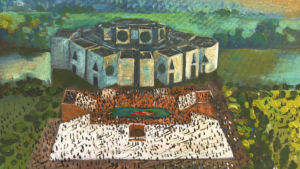

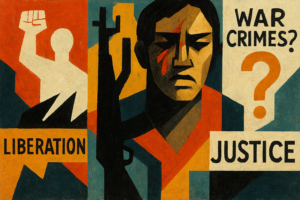
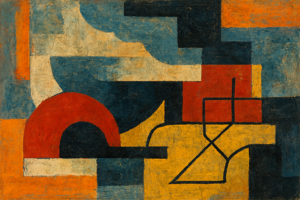
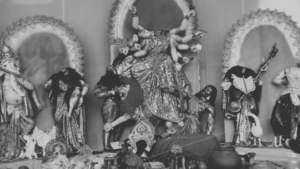
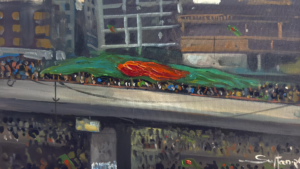

A comprehensive, bold, and well-written article full of historic facts, proper reasoning and logical justifications.
Eagerly waiting for its sequel…